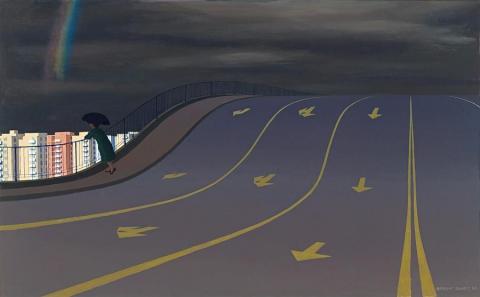THE RAINBOW, 1965
JEFFREY SMART
oil on board
50.0 x 80.0 cm
signed and dated lower right: JEFFREY SMART 65
signed and titled verso: J. SMART. / “RAINBOW”
Sotheby's, Melbourne, 22 April 1996, lot 68
Private collection, Sydney
Sotheby's, Sydney, 26 November 2007, lot 30
Private collection, Brisbane
Jeffrey Smart, Galleria 88, Rome, 8–23 April 1965, cat. 21
Jeffrey Smart, Macquarie Galleries, Sydney, 29 September – 11 October 1965, cat. 12
Thornton, W., 'Jeffrey Smart's Exhibition', Sydney Morning Herald, 29 September 1965, p. 21
Gleeson, J., 'Jeffrey Smart's “still” lifes', Sun-Herald, Sydney, 3 October 1965, p. 76
Jeffrey Smart employs the everyday things of our time to conjure up the enigmatic with brilliant effect. As Wallace Thornton wrote of Smart's 1965 solo exhibition at Sydney's Macquarie Galleries (which included The Rainbow), 'He exposes the familiar with the sharpened impact of a new experience.'1 Highways, traffic signs, and the bland faces of apartment blocks are well-known motifs; but it is often the rise in the road and overpass with its sharp-edged horizon that gives his work such dramatic appeal. It is a favoured device which emerged early in his art. A fine example is Approaching Storm By Railway 1955 (private collection), and reaches heights of special significance in The Cahill Expressway 1962 (National Gallery of Victoria), and Self Portrait 1964-65 (private collection). Approach to a City III 1968-69 (private collection), with its reversal of composition, is almost a pendant, complementing The Rainbow in ideas and mood. Details vary, the former being more populated, introducing the motif of the rear view of the truck on the rise, which reaches its climax in one of Smart's later masterpieces, The Guiding Spheres II (Homage to Cézanne) 1979-80 (private collection).
In The Rainbow, the swell of the overpass is pregnant with expectation and the questioning of what might be over the top. Although traffic arrows descend, leading away, the eye hovers on that brink of the unknown - the narrow edge between existence and oblivion. Smart marries these uncertainties to darkened and threatening skies of a breathless stillness. Yet, in a painting full of incident, the paradox of emptiness reigns. It is palpable- neither roads nor apartments evidence any life, except for the lone figure, who turns her back on the viewer. It is another of Smart's metaphors for the emptiness of modern life. The rainbow, however, that ancient Biblical symbol of reconciliation between God and man, hints at salvation. Placed knowingly above the rows of apartments and viewed by the dark figure looking over the rail, it promises hope in finding a way out of the urbanized entrapment and its manacles of freeways. James Gleeson was so impressed with Smart's1965 Sydney exhibition that he devoted his entire Sunday feature article to exploring other facets of the enigma that is Smart. In a highly perceptive review, he wrote of the storyteller whose paintings do not tell a story.'Dark highways', he continued, 'are dressed in pointing yellow arrows but there is nothing to obey their instructions.'2 And finally - 'Smart preserves a façade of objectivity even when he is being most subjective.' Smart is the master of balance and immaculate surfaces. What lies behind them is what makes his art so fascinating.
1. Thornton, W., 'Jeffrey Smart's Exhibition', Sydney Morning Herald, 29 September 1965, p. 21
2. Gleeson, J., 'Jeffrey Smart's 'still' lifes', Sun-Herald, Sydney, 3 October 1965, p. 76
DAVID THOMAS
